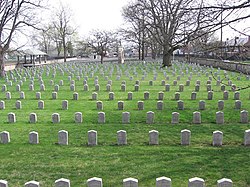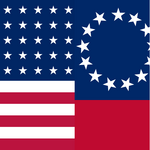Portal:American Civil War
 |
 |


The American Civil War (1861–1865) was a sectional rebellion against the United States of America by the Confederate States, formed of eleven southern states' governments which moved to secede from the Union after the 1860 election of Abraham Lincoln as President of the United States. The Union's victory was eventually achieved by leveraging advantages in population, manufacturing and logistics and through a strategic naval blockade denying the Confederacy access to the world's markets.
In many ways, the conflict's central issues – the enslavement of African Americans, the role of constitutional federal government, and the rights of states – are still not completely resolved. Not surprisingly, the Confederate army's surrender at Appomattox on April 9,1865 did little to change many Americans' attitudes toward the potential powers of central government. The passage of the Thirteenth, Fourteenth and Fifteenth amendments to the Constitution in the years immediately following the war did not change the racial prejudice prevalent among Americans of the day; and the process of Reconstruction did not heal the deeply personal wounds inflicted by four brutal years of war and more than 970,000 casualties – 3 percent of the population, including approximately 560,000 deaths. As a result, controversies affected by the war's unresolved social, political, economic and racial tensions continue to shape contemporary American thought. The causes of the war, the reasons for the outcome, and even the name of the war itself are subjects of much discussion even today. (Full article)
The Battle of Garnett's and Golding's Farms took place June 27–28, 1862, in Henrico County, Virginia, as part of the Seven Days Battles of the American Civil War's Peninsula Campaign. While the battle at Gaines's Mill raged north of the Chickahominy River, the forces of Confederate general John B. Magruder conducted a reconnaissance in force that developed into a minor attack against the Union line south of the river at Garnett's Farm. The Confederates attacked again near Golding's Farm on the morning of June 28 but in both cases were easily repulsed. The action at the Garnett and Golding farms accomplished little beyond convincing McClellan that he was being attacked from both sides of the Chickahominy. (Full article...)
Nevada's entry into statehood in the United States on October 31, 1864, in the midst of the American Civil War, was expedited by Union sympathizers in order to ensure the state's participation in the 1864 presidential election in support of President Abraham Lincoln. Thus Nevada became one of only two states admitted to the Union during the war (the other being West Virginia) and earned the nickname that appears on the Nevada state flag today: "Battle Born".
Because its population at statehood was less than 40,000, Nevada was only able to muster 1,200 men to fight for the Union Army, but Confederate forces never posed any serious threat of territorial seizure, and Nevada remained firmly in Union control for the duration of the war. Largely isolated from the major theaters of the conflict, Nevada nonetheless served as an important target for political and economic strategists before and after gaining statehood. Its main contribution to the cause came from its burgeoning mining industry: at least $400 million in silver ore from the Comstock Lode was used to finance the federal war effort. In addition, the state hosted a number of Union military posts. (Full article...)
J. R. Kealoha (died March 5, 1877) was a Native Hawaiian and a citizen of the Kingdom of Hawaiʻi, who became a Union Army soldier during the American Civil War. Considered one of the "Hawaiʻi sons of the Civil War", he was among a group of more than one hundred documented Native Hawaiian and Hawaiʻi-born combatants who fought in the American Civil War while the Kingdom of Hawaiʻi was an independent nation.
Kealoha enlisted in the 41st United States Colored Infantry, a United States Colored Troops regiment formed in Pennsylvania. Participating in the siege of Petersburg, he and another Hawaiian soldier met the Hawaiʻi-born Colonel Samuel Chapman Armstrong, who recorded their encounter in a letter home. With the 41st USCT, Kealoha was present at the surrender of Confederate General Robert E. Lee and the Army of Northern Virginia at Appomattox Court House on April 9, 1865. After the war, Kealoha returned to Hawaiʻi. He died on March 5, 1877, and was buried in an unmarked grave in Honolulu's Oʻahu Cemetery. (Full article...)
- ... that Chinese-born Joseph Pierce enlisted as a Union Army soldier, fought at the Battle of Gettysburg during the American Civil War, and was made a corporal?
- ... that at the Battle of La Haye-du-Puits in July 1944, a Confederate flag dating to the American Civil War was raised over the town?
- ... that Enoch Marvin Banks resigned from the University of Florida because of public outrage over his belief that the American Civil War was caused by slavery?
- ... that Romeo and Juliet both served in the Union Navy?
- ... that Justus H. Rathbone, founder of the Knights of Pythias, served as a hospital steward during the American Civil War?
- ... that Benjamin Jackson was likely paid at least $300 to fight in the American Civil War as Lewis Saunders?
- Attention needed
- ...to referencing and citation • ...to coverage and accuracy • ...to structure • ...to grammar • ...to supporting materials
- Popular pages
- Full list
- Cleanup needed
- The West Tennessee Raids
- Requested articles
- James Ashby (soldier) • Benjamin D. Fearing • James B. Speers • Charles S. Steedman • Battle of Barton's Station • Lawrence P. Graham • Frederick S. Sturmbaugh • Davis Tillson • Action at Nineveh (currently a redirect) • International response to the American Civil War • Spain and the American Civil War • Savannah Campaign Confederate order of battle • Native Americans in the American Civil War (currently disambiguation after deletion) • Battle of Lafayette • Battle of Sunshine Church • Requested American Civil War Medal of Honor recipients
- Expansion needed
- Battle of Boonsborough • Battle of Guard Hill • Battle of Rice's Station • Battle of Simmon's Bluff • Battle of Summit Point • Charleston Arsenal • Edenton Bell Battery • First Battle of Dalton • Blackshear Prison • Edwin Forbes • Hiram B. Granbury • Henry Thomas Harrison • Louis Hébert (colonel) • Benjamin G. Humphreys • Maynard Carbine • Hezekiah G. Spruill • Smith carbine • Edward C. Walthall • Confederate States Secretary of the Navy • Confederate States Secretary of the Treasury • David Henry Williams • Battle of Rome Cross Roads • Delaware in the American Civil War • Ironclad Board • United States Military Railroad • Kansas in the American Civil War • Rufus Daggett • Ebenezer Magoffin • Confederate Quartermaster-General's Department • First Corps, Army of Northern Virginia • Francis Laurens Vinton • Henry Maury • Smith's Expedition to Tupelo • Other American Civil War battle stubs • Other American Civil War stubs
- Images needed
- Battle of Lone Jack • Preston Pond, Jr. • Melancthon Smith
- Merging needed
- 1st Regiment New York Mounted Rifles and 7th Regiment New York Volunteer Cavalry
- Citations needed
- 1st Alabama Cavalry Regiment (Union) • 4th Maine Battery • 33rd Ohio Infantry • 110th New York Volunteer Infantry • Battle of Hatcher's Run • Camp Dennison • Confederate colonies • CSS Resolute • Dakota War of 1862 • Florida in the American Civil War • Ethan A. Hitchcock (general) • Fort Harker (Alabama) • Gettysburg (1993 film) • Iowa in the American Civil War • Second Battle of Fort Sumter • Samuel Benton
- Translation needed
- Add an article here!
The following Wikimedia Foundation sister projects provide more on this subject:
-
Commons
Free media repository -
Wikibooks
Free textbooks and manuals -
Wikidata
Free knowledge base -
Wikinews
Free-content news -
Wikiquote
Collection of quotations -
Wikisource
Free-content library -
Wikiversity
Free learning tools -
Wikivoyage
Free travel guide -
Wiktionary
Dictionary and thesaurus
- Shortcuts to this page: Portal:ACW • P:ACW



































































